

Cantor's paradox. In set theory, Cantor's paradox is derivable from the theorem that there is no greatest cardinal number, so that the collection of "infinite sizes" is itself infinite.
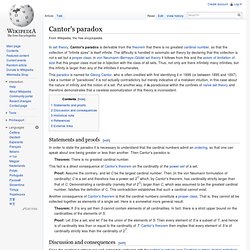
The difficulty is handled in axiomatic set theory by declaring that this collection is not a set but a proper class; in von Neumann–Bernays–Gödel set theory it follows from this and the axiom of limitation of size that this proper class must be in bijection with the class of all sets. Thus, not only are there infinitely many infinities, but this infinity is larger than any of the infinities it enumerates. This paradox is named for Georg Cantor, who is often credited with first identifying it in 1899 (or between 1895 and 1897). Like a number of "paradoxes" it is not actually contradictory but merely indicative of a mistaken intuition, in this case about the nature of infinity and the notion of a set.
Statements and proofs[edit] Theorem: There is no greatest cardinal number. Discussion and consequences[edit] Russell's paradox. In the foundations of mathematics, Russell's paradox (also known as Russell's antinomy), discovered by Bertrand Russell in 1901, showed that the naive set theory created by Georg Cantor leads to a contradiction.
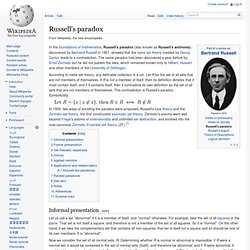
The same paradox had been discovered a year before by Ernst Zermelo but he did not publish the idea, which remained known only to Hilbert, Husserl and other members of the University of Göttingen. In 1908, two ways of avoiding the paradox were proposed, Russell's type theory and the Zermelo set theory, the first constructed axiomatic set theory. Zermelo's axioms went well beyond Frege's axioms of extensionality and unlimited set abstraction, and evolved into the now-canonical Zermelo–Fraenkel set theory (ZF).[1] Informal presentation[edit] Now we consider the set of all normal sets, R. Formal presentation[edit] and the following axiom schema of unrestricted comprehension: for any formula P with only the variable x free. For . A contradiction.
Set-theoretic responses[edit] or "elect" Barber paradox. This article is about a paradox of self-reference.
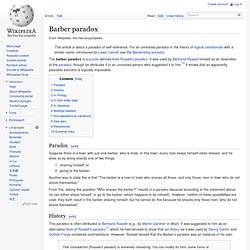
EPR paradox. Albert Einstein The EPR paradox is an early and influential critique leveled against the Copenhagen interpretation of quantum mechanics.
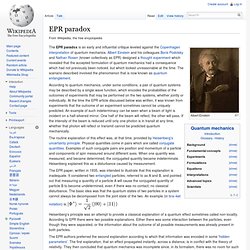
Albert Einstein and his colleagues Boris Podolsky and Nathan Rosen (known collectively as EPR) designed a thought experiment which revealed that the accepted formulation of quantum mechanics had a consequence which had not previously been noticed, but which looked unreasonable at the time. The scenario described involved the phenomenon that is now known as quantum entanglement. According to quantum mechanics, under some conditions, a pair of quantum systems may be described by a single wave function, which encodes the probabilities of the outcomes of experiments that may be performed on the two systems, whether jointly or individually.
At the time the EPR article discussed below was written, it was known from experiments that the outcome of an experiment sometimes cannot be uniquely predicted. Sorites paradox. The change in size between consecutive "big" heaps (left) is twice that of the change between consecutive "little" heaps (right), yet seems less significant.
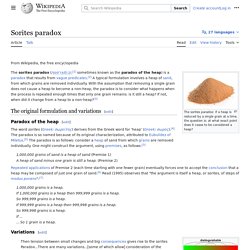
Hilbert's paradox of the Grand Hotel. The paradox[edit] Consider a hypothetical hotel with a countably infinite number of rooms, all of which are occupied.
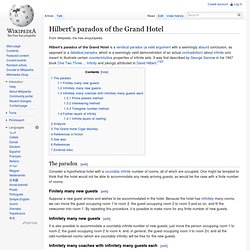
One might be tempted to think that the hotel would not be able to accommodate any newly arriving guests, as would be the case with a finite number of rooms. Finitely many new guests[edit] Suppose a new guest arrives and wishes to be accommodated in the hotel. Because the hotel has infinitely many rooms, we can move the guest occupying room 1 to room 2, the guest occupying room 2 to room 3 and so on, and fit the newcomer into room 1. Infinitely many new guests[edit] It is also possible to accommodate a countably infinite number of new guests: just move the person occupying room 1 to room 2, the guest occupying room 2 to room 4, and, in general, the guest occupying room n to room 2n, and all the odd-numbered rooms (which are countably infinite) will be free for the new guests.
Infinitely many coaches with infinitely many guests each[edit] , and their coach number to be and. Removing Roads and Traffic Lights Speeds Urban Travel. Conventional traffic engineering assumes that given no increase in vehicles, more roads mean less congestion.
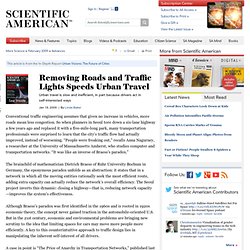
So when planners in Seoul tore down a six-lane highway a few years ago and replaced it with a five-mile-long park, many transportation professionals were surprised to learn that the city’s traffic flow had actually improved, instead of worsening. “People were freaking out,” recalls Anna Nagurney, a researcher at the University of Massachusetts Amherst, who studies computer and transportation networks. “It was like an inverse of Braess’s paradox.” The brainchild of mathematician Dietrich Braess of Ruhr University Bochum in Germany, the eponymous paradox unfolds as an abstraction: it states that in a network in which all the moving entities rationally seek the most efficient route, adding extra capacity can actually reduce the network’s overall efficiency.